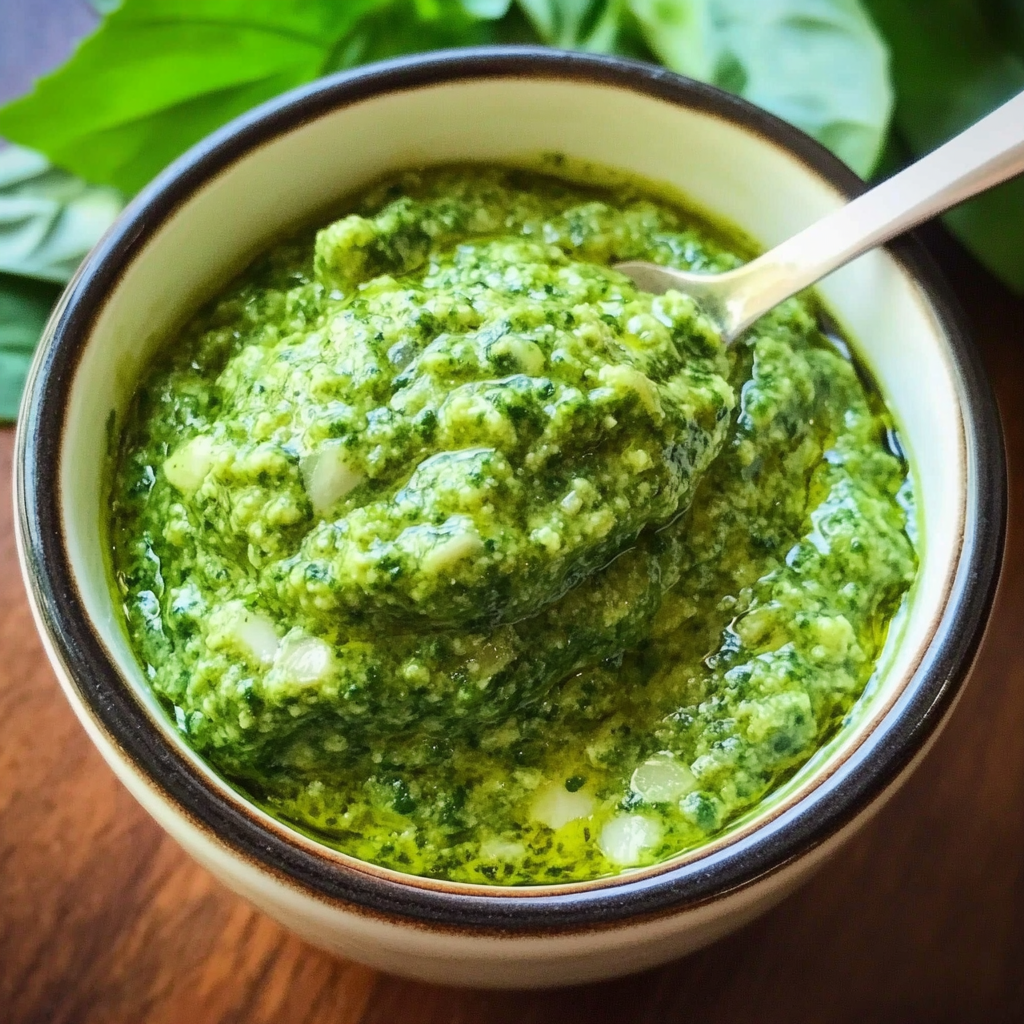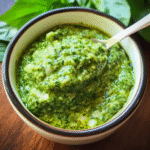🌿 Introduction to Pesto Recipe
Few sauces are as universally loved and versatile as pesto recipe. Originally from Genoa, in the Liguria region of Italy, pesto—from the Italian word “pestare” meaning “to pound” or “crush”—was traditionally made by grinding ingredients using a mortar and pestle. The classic pesto alla Genovese combines fresh basil, garlic, pine nuts, Parmesan cheese, and extra virgin olive oil into a bright green, flavorful paste.
What makes pesto truly remarkable is its ability to complement a wide variety of dishes, from pasta and pizza to sandwiches and salads. Its intense aroma, punchy garlic flavor, and creamy texture make it a go-to condiment for both quick meals and gourmet creations. Whether you’re whipping up a fast weeknight dinner or impressing guests with an appetizer platter, homemade pesto adds instant freshness and bold Italian flair. In this guide, we’ll explore not just how to make it, but how to personalize and maximize its use.
Try pairing it with simple, adaptable recipes like summer vegetable stew or healthy overnight breakfast casserole for a complete meal.
🌱 What Is Pesto?
Pesto is a traditional Italian sauce known for its rich, herbaceous flavor and vibrant green color. The word pesto comes from the Genoese verb “pestare,” which means “to pound” or “crush”—a nod to its original preparation using a mortar and pestle. The most iconic version, pesto alla Genovese, hails from Genoa and is made with fresh basil leaves, garlic, pine nuts, Parmesan cheese, and extra virgin olive oil.
While basil pesto is the most recognized variation, the term “pesto” can also refer to any crushed sauce made in a similar style, including ones made with different herbs, vegetables, or nuts. Its appeal lies in its raw, unheated preparation, preserving the natural oils and intense flavor of each ingredient.
Today, pesto is often prepared in a blender or food processor, making it faster while still delivering its signature freshness. It’s a flavorful, nutrient-dense condiment that pairs beautifully with countless savory dishes.
Today, pesto is made with a food processor, but the essential flavor remains the same. Using high-quality olive oil is key to balancing richness and brightness in the sauce.
🧄 Classic Basil Pesto Recipe
Making basil pesto from scratch is surprisingly quick, easy, and rewarding. With just a few ingredients and a food processor, you can create a sauce that’s far fresher and more flavorful than anything you’ll find in a jar.
📝 Ingredients
- 2 cups fresh basil leaves (packed)
- ½ cup toasted pine nuts
- 1 small garlic clove, peeled
- 2 tablespoons fresh lemon juice (optional, adds brightness)
- ¼ cup extra virgin olive oil (plus more for desired consistency)
- ¼ cup freshly grated Parmesan cheese (or vegan alternative)
- ¼ teaspoon sea salt, plus more to taste
- Freshly ground black pepper, to taste
🔧 Equipment
- Food processor or high-speed blender
- Spatula
- Measuring cups and spoons
- Airtight storage jar
👩🍳 Step-by-Step Instructions For Pesto Recipe
- Toast the pine nuts
Lightly toast pine nuts in a dry skillet over medium heat until golden and fragrant (about 3–4 minutes). Let them cool before blending. - Start the base
In your food processor, combine the pine nuts, garlic, lemon juice, salt, and pepper. Pulse a few times until finely chopped. - Add the basil
Add the basil leaves and pulse again, scraping down the sides as needed, until well incorporated. - Drizzle in olive oil
With the machine running, slowly drizzle in the olive oil to emulsify and create a smooth, creamy texture. - Add Parmesan
Add in the Parmesan cheese (or vegan alternative) and pulse a few more times to blend. Taste and adjust seasoning as desired.
💡 Tips for Success
- For a smoother texture, add a touch more olive oil until desired consistency is reached.
- Use cold ingredients to help keep the pesto bright green.
- If storing, pour a thin layer of olive oil on top to prevent oxidation.
This simple, flavorful recipe makes about 1 cup of pesto—perfect for tossing with pasta, drizzling over roasted veggies, or spreading on sandwiches.

🥗 Nutritional Snapshot
Per 2-tablespoon serving:
- ~160 calories
- High in monounsaturated fats from olive oil
- Rich in vitamin K and antioxidants from basil
- Gluten-free and vegetarian
- Easily made vegan by omitting cheese
❄️ Storing & Freezing Pesto Recipe
Pesto is best enjoyed fresh, but with proper storage, you can extend its life without sacrificing flavor. Store homemade pesto in an airtight container in the refrigerator for up to 5 days. To prevent oxidation and browning, smooth the surface and pour a thin layer of olive oil on top before sealing. For longer storage, freeze pesto in ice cube trays, then transfer the frozen cubes to a freezer bag—perfect for single servings. Frozen pesto maintains its quality for up to 3 months. Just thaw as needed and stir before using to restore its creamy consistency.
🧀 How to Make Vegan or Dairy-Free Pesto recipe
Making a vegan or dairy-free pesto is simple, and the result is just as flavorful and creamy as the classic version. The main ingredient to replace is Parmesan cheese, which adds umami and richness. Fortunately, there are a few easy and delicious alternatives:
- Nutritional yeast – A popular choice that delivers a cheesy, nutty flavor and is rich in B-vitamins. Use 2–3 tablespoons to start.
- Vegan Parmesan cheese – Store-bought or homemade versions often combine cashews, garlic powder, and lemon juice for a similar effect.
- Omit the cheese – Boost flavor with a bit of extra garlic, lemon juice, or salt to maintain balance.
All other ingredients—basil, olive oil, pine nuts, and garlic—are naturally vegan. Just blend as usual, adjusting the seasoning to taste. This variation is perfect for anyone with dairy allergies or those following a plant-based lifestyle.
Print
Homemade Pesto Recipe
- Total Time: 5 minutes
- Yield: 1 cup (~8 servings) 1x
- Diet: Vegetarian
Description
A vibrant, fresh basil pesto made with simple ingredients like pine nuts, Parmesan cheese, garlic, and olive oil. Ready in minutes and perfect for pasta, veggies, or spreads
Ingredients
-
2 cups fresh basil leaves (packed)
-
½ cup toasted pine nuts
-
1 small garlic clove, peeled
-
2 tablespoons fresh lemon juice (optional)
-
¼ cup extra virgin olive oil, plus more as needed
-
¼ cup Parmesan cheese, grated (or vegan alternative)
-
¼ teaspoon sea salt
-
Freshly ground black pepper, to taste
Instructions
-
In a food processor, combine pine nuts, garlic, lemon juice, salt, and pepper. Pulse until finely chopped.
-
Add basil leaves and pulse until combined.
-
With the processor running, slowly drizzle in olive oil until emulsified.
-
Add Parmesan cheese and pulse briefly until smooth.
-
Taste and adjust seasoning as needed. Add more olive oil for a thinner consistency.
Notes
-
For vegan pesto, replace cheese with nutritional yeast or omit it altogether.
-
Toasting the nuts enhances flavor.
-
Store in an airtight container with a thin oil layer on top to prevent browning.
-
Freeze in ice cube trays for quick, single servings.
- Prep Time: 5 minutes
- Cook Time: 0 minutes
- Category: Sauce/Condiment
- Method: Blending
- Cuisine: Italian
Nutrition
- Calories: ~170 kcal
- Sugar: <1g
- Sodium: 120mg
- Fat: 18g
- Saturated Fat: 2.5g
- Carbohydrates: 2g
- Fiber: 0.5g
- Protein: 2g
- Cholesterol: 3mg
🌀 Creative Pesto Variations
One of the best things about pesto is how easy it is to customize. While traditional basil pesto is a classic, experimenting with different ingredients can yield exciting new flavors and textures. Whether you’re adapting to dietary needs, using what you have on hand, or just feeling adventurous, here are some creative pesto variations to try:
🌰 Nut Variations
If pine nuts are too pricey or unavailable, try these alternatives:
- Walnuts – slightly bitter, great for heartiness
- Almonds – sweet and mild, especially when blanched
- Cashews – creamy and rich, perfect for a smoother pesto
- Sunflower seeds or pepitas – nut-free options that still add texture
- Pistachios – unique and sweet-savory, great with mint or arugula
🌿 Greens and Herbs
Swap out basil entirely or combine it with other greens for a fresh twist:
- Arugula – peppery and bold, pairs well with lemon
- Spinach – mellow, nutrient-rich, and budget-friendly
- Kale – hearty and robust; blanch first for tenderness
- Cilantro – bright and citrusy, ideal for Tex-Mex or Asian-inspired dishes
- Mint or parsley – great for lamb dishes or Mediterranean flavors
🍅 Flavor Boosters
Add depth or zing to your pesto with a mix-in or two:
- Sun-dried tomatoes – creates a rustic pesto rosso
- Roasted red peppers – sweet and smoky
- Avocado – adds creaminess and healthy fats
- Charred jalapeño – for a spicy kick
- Lemon zest or juice – enhances brightness
- Nutritional yeast – extra umami for dairy-free versions
Or take it sweet and savory by experimenting with ingredients like those in blackberry basil ricotta pizza, where basil meets fruity indulgence.
🍝 10 Delicious Ways to Use Pesto recipe
Tired of pasta? Here’s how to think beyond the noodles:
- Toss with roasted or grilled vegetables
- Drizzle over grilled chicken or salmon
- Spread on sandwiches, bagels, or toast
- Mix into scrambled eggs or omelets
- Use as a pizza base sauce
- Add to soups like minestrone
- Swirl into mashed potatoes or risotto
- Spoon over grain bowls or couscous
- Dip for crusty bread or flatbreads
- Stir into hummus, mayo, or yogurt for dips
🌍 Pesto recipe Around the World
Not all pesto is green and basil-based! Try:
- Pesto Rosso – Sicilian red pesto made with sun-dried tomatoes
- Thai pesto – Uses cilantro, peanuts, and lime
- Mint pesto – Refreshing with lamb or spring vegetables
- Kale walnut pesto – Earthy and robust
⚠️ Common Mistakes to Avoid
Avoid these pitfalls to keep your pesto bright and flavorful:
- Over-blending → makes it bitter
- Wet herbs → dilute flavor
- Cheap olive oil → ruins texture
- Skipping acid or salt → flat taste
- Adding cheese too early → can gum up
Frequently Asked Questions About Pesto Recipe ❓
🔹 Can you freeze pesto sauce?
Yes! Use ice cube trays for individual portions. Once frozen, transfer to freezer bags and use within 6 months.
🔹 What’s the best substitute for pine nuts?
Walnuts are the closest alternative. Almonds and pistachios also work well.
🔹 Can I make pesto without a food processor?
Yes. Use a mortar and pestle for a traditional method, or finely chop ingredients and mash them together.
🔹 Is pesto healthier than marinara sauce?
It depends on dietary goals. Pesto is higher in fat but full of healthy fats, while marinara is lower in calories but higher in carbs.
🔹 How can I tell if pesto has gone bad?
Signs include:
- Brown or gray discoloration
- Sour or off-smell
- Mold on the surface
💬 Final Thoughts: Why Homemade Pesto recipe Is Worth It
Store-bought pesto recipe often contains preservatives, lower-quality oils, or unnecessary fillers. Making your own gives you:
- Control over ingredients and flavor
- A fresher, brighter taste
- The flexibility to customize for dietary needs
Pesto is more than a sauce—it’s a celebration of fresh ingredients and bold flavors. Whether you stick to tradition or go wild with variations, once you make it yourself, you may never go back.



